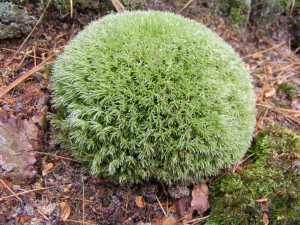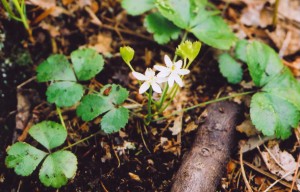
Club-moss
As the snow melts, again, the forest floor once more emerges, and the plants and animals that rested under their frozen quilt can again see the light of day. And be seen by us. I’m always happy to see the little springtails and spiders, frogs and snakes that are once again uncovered and active. And, for that matter, the amount of green vegetation that can be seen among last year’s dead leaves. While many plants die back to avoid desiccation, there are many that retain their green essence throughout the winter protected by the snow.
On our trails, the woodferns (Dryopteris sp.) are perhaps the largest and most obvious of the green plants of the subnivean (beneath the snow) world. Although they remain green, they have been flattened by the weight of snowcover and don’t quite reflect their summer splendor. Still, among the leaf litter their color is a reminder of the abundant plant growth to come.
Clubmosses, or Lycopodium also remain green. Like ferns they are primitive plants that resemble either tiny pine trees or oversized pipe cleaners and are bristly rather than leafy in appearance. There are several different species that thrive in the cool moist and shady conditions near the Lakeshore, and like ferns they reproduce by spores rather than flowers and seeds. A colony of these plants can carpet many square feet of the forest floor.
True mosses, including the pincushion moss (Leucobryum sp.) are delightful little round masses of soft green scattered throughout the forest on the soil and on rocks and rotting logs. They are another very old class of plants that have successfully survived for millions of years, predating the flowering plants. They can survive very harsh conditions, but like the clubmosses thrive where there is moisture, shade, and cool temperatures. They, along with lichens, help to produce soil upon which other plants can grow and provide a home for small insects and other animals.
And then there are the flowering plants which are both hardy and are very low-growing so that they remain below snow cover. Partridgeberry (Mitchella) is one, with thick, dark, striped leaves crawling close to the ground. Wintergreen (Gaultheria) is another, and although similar is a member of a different family. It grows more upright but only to the height of a few inches. Sometimes Canada dogwood, our smallest woody shrub, retains some green under the snow. Goldthread (Coptis) is very interesting, as it has thinner, more delicate, shiny 3-lobed leaves creeping over the surface. It’s roots are indeed a yellow-gold color, hence it’s name.

Goldthread
Among the brown leaves of last year and the foliage of the evergreen plants above, in wet areas like Woodland Dunes you might also find something purple and bizarre- the emerging flowers of skunk cabbage. Like the claws of alien beasts these pointed, horn-shaped green-speckled purple “flowers” erupt from the mucky soil. Inside each horn is a weird looking spiky, knobby structure which gives off a foul odor to attract pollinating flies. These plants are a delightful contrast to the lovely soft green plants described above, and a reminder that there are many different ways that living things find to survive and multiply.
When I look out at the mud-covered landscape of early spring in my yard, it’s hard to feel inspired. But a walk in the forest always reveals something interesting and enjoyable.
